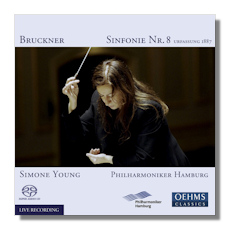
The Internet's Premier Classical Music Source
Related Links
- Bruckner Reviews
- Latest Reviews
- More Reviews
-
By Composer
-
Collections
DVD & Blu-ray
Books
Concert Reviews
Articles/Interviews
Software
Audio
Search Amazon
Recommended Links
Site News
 SACD Review
SACD Review
Anton Bruckner

Symphony #8
Philharmonike Hamburg/Simone Young
Oehms Classics SACD OC638 2Discs 82:41 Hybrid Multichannel
This well-produced and nicely packaged 2-SACD set continues Simone Young's Bruckner cycle with the Philharmonike Hamburg. The basic premise of the cycle is that Bruckner's first thoughts represent his deepest intentions, with all subsequent revisions simply compromises. Accordingly in the 8th Young offers one of the few recordings of the 1887 first version, which was only published in 1971 and performed for the first time in 1973 by Hans-Hubert Schönzeler. It has since been recorded by Georg Tintner, Eliahu Inbal, and a handful of others.
The 1887 score (embarrassingly misdated to 1878 on the back of the case) is quite a bit longer than the 1890 version most often performed and recorded. This recording stretches to over 83 minutes, which Oehms has chosen to package in two discs. Fortunately the 2-disc set seems priced to compete with the more standard single-disc recordings.
Bruckner's revisions to the 1887 score were inspired by Hermann Levi's famous rejection. The single most striking difference from the more familiar 1890 version is at the end of the first movement, which closes with a fff tutti rather than the gradual dissolution that works to such telling effect in the revised coda. The Scherzo has some unusual glissando passages and no harps in the Trio, while the Adagio has 5 extra cymbal crashes at the climax of the movement and an additional 38 bars. The principal change in the finale is in the instrumentation, with four additional horns replacing the Wagner tubas from earlier movements.
There is no doubt in my mind that this is a tremendous performance. Young and the Philharminike Hamburg bring the 1878 version to life with a great sense of structure. The pacing and detail keep the listener engaged throughout the very lengthy performance and the sound quality is terrific, especially for a live performance. Recordings of the less well-known versions of Bruckner symphonies can sometimes sound antiquarian. This one certainly does not.
I cannot agree, though, with Michael Lewin's claim in the program notes that "the true content of the 8th Symphony can be perceived only in its original form". I don't see much profit in trying to find the single best version of any of the symphonies. The 1878 version has its strengths. In many respects it is bolder than the 1890 version, and the sound world is interestingly different. But it also has some definite weaknesses. The fff ending in the first movement is much less compelling to my ear than the pp close in the 1890 version, and the build up to the great climax in the Adagio is less sustained and corresponding less powerful than the surging seas of sound in the revision.
But this really is a minor problem. It may well be that Young and the Philharmonike play with such conviction because they believe that they are playing the "one true version". If so, more power to them. But we can take a more measured perspective, welcoming a strong addition to what is already a very strong field without getting involved in pointless discussions about which version best represents Bruckner's real intentions. This disc is highly recommended
Copyright © 2015, José Luis Bermúdez




















